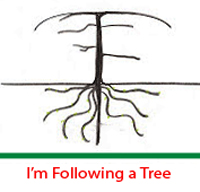
Browning leaves at the top of one of the 100 elms (Ulmus ‘New Horizon’

It’s November – the days are getting shorter and the shops have already started playing Christmas songs (it must be terrible to work there).
We have had out first frost here in Cardiff, although there is still plenty of rain, too.
The 100 disease-resistant elms, Ulmus ‘New Horizon’, in Cardiff’s Pontcanna Fields still seem green from a distance, but up close the leaves are looking rather poorly.

The sun is low in the sky and the long shadows of the tall avenue of old elm trees cloak one end of the avenue of elms

Looking along the elm avenue – the trees seem green…

…but the treetops are golden, and not in a good way

Some of the leaves are yellow or brown and there are big spots…

…some of the brown spots remind me of the marking of St Peter’s thumbprint on the flank of the fish we call John Dory (Zeus faber)

Sunlight through leaves

Heart-shaped golden leaf – but even this is flawed

A mass of leaves and branches

A shady view across the row of elms to the lime (linden) avenue beyond

The opposite view across the elms to an open field

The markings on a fallen elm leaf
Can anyone diagnose the problem? I was wondering if it was just chlorosis (yellowing) caused by lack of iron? Or this combined with changes in the weather – warm and wet, then cold and dry?
Could it be scorch? I see there is something called bacterial leaf scorch, but that seems to affect the leaf margins.
There are various elm diseases described here but the images don’t resemble the leaves I have seen.
There are many sycamore maples in the fields that have tar spot (Rhytisma acerinum), which is a good indicator of clean air, but this looks very different.
I also wondered about the black spot I have previously seen on roses (Diplocarpon rosae).
I should have picked up a leaf and looked closer to see if I could detect fungal bodies, but I didn’t.
These elms are supposed to be disease resistant, at least against the notorious Dutch elm disease of my childhood. I do hope this avenue is OK, but the browning of their crowns is a bit of a worry.
Find out more about the 100 elms here.
Or find out more about tree following here.


I wonder if you were to send photographs to iSpot that someone there might be able to help. They seem to have a lot of people who are experts in many fields.
Thank you for the suggestion, I’ll think about that – although I don’t want to overstep the mark as the trees don’t belong to me!
I noticed today that my own Liquidambar has also got brown spots all over its autumn leaves, so it may just be a damp autumn…
All the best 🙂
Can’t diagnose it but I can tell you what it isn’t, which is rose blackspot. The fungus that causes blackspot on roses only attacks roses, no other plants.
Thanks for that – I guess I should have known, as my father used to grow roses!
I suppose I was wondering if there was a related disease for elms…
All the best 🙂
There are sycamores right by my new house – and I’ve been puzzled by the black spots on their leaves so maybe you’ve sold my puzzle about what causes them. However, thetrees are growing right by a main road so either it’s not tar spot after all – or the ‘clean air’ indicator isn’t as efficient as one might hope.
The avenues look lovely.
re. iSpot. I don’t think it matters if the trees aren’t yours – but I’ve rather given up on it because it works so slowly now. They had some security issues with the websites and the changes they had to make to sort it have made it very lugubrious. I used to rely on it a lot for confirming IDs and miss it.
Thanks for all that.
Tar spot is quite distinctive and black – so maybe your air is cleaner than you thought.
I am feeling less worried about the elms now, as I have seen similar browning on many different trees since then. I think it must just be the weather.
All the best 🙂